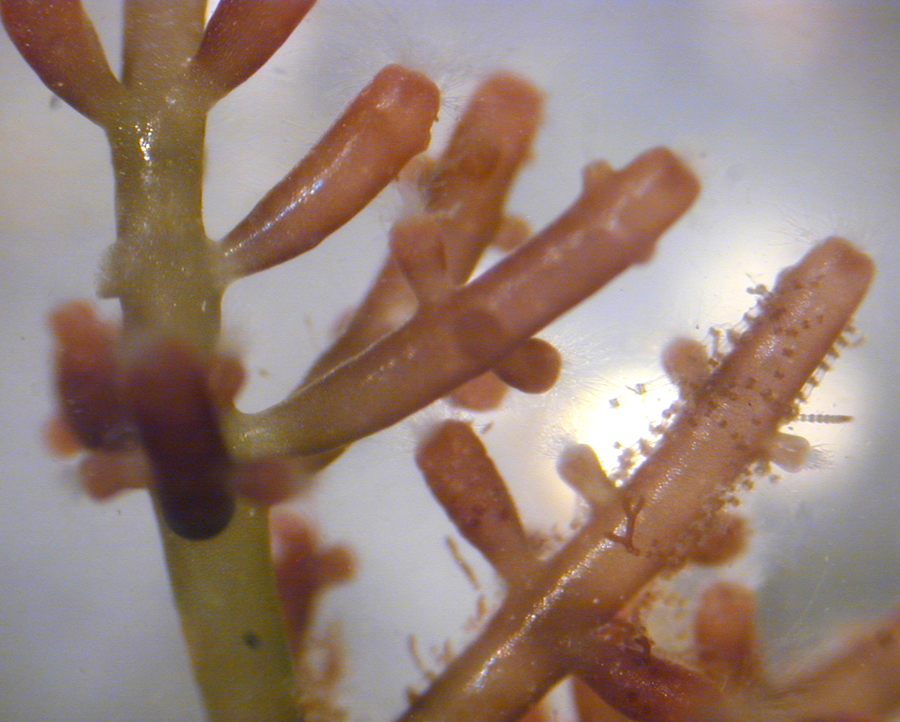Florideophyceae on:
[Wikipedia]
[Google]
[Amazon]
Florideophyceae is a class of exclusively multicellular Complete mitochondrial genomes of six species of the freshwater red algal order Batrachospermales (Rhodophyta)
/ref>
 There are various classification schemes; see
There are various classification schemes; see
Tree of Life: Florideophyceae
{{Taxonbar, from=Q1002125
red algae
Red algae, or Rhodophyta (, ; ), make up one of the oldest groups of eukaryotic algae. The Rhodophyta comprises one of the largest Phylum, phyla of algae, containing over 7,000 recognized species within over 900 Genus, genera amidst ongoing taxon ...
. They were once thought to be the only algae to bear pit connection In algal anatomy, a pit connection is a hole in the septum between two algal cells, and is found only in multicellular red algae − specifically in the subphylum Eurhodophytina, except haploid Bangiales. They are often stoppered with proteinaceous ...
s, but these have since been found in the filamentous stage of the Bangiaceae. They were also thought only to exhibit apical growth, but there are genera known to grow by intercalary growth. Most, but not all, genera have three phases to the life cycle. In the subclass Nemaliophycidae there are three orders, Balbianiales, Batrachospermales, and Thoreales, which lives exclusively in freshwater./ref>
Classification
 There are various classification schemes; see
There are various classification schemes; see red algae
Red algae, or Rhodophyta (, ; ), make up one of the oldest groups of eukaryotic algae. The Rhodophyta comprises one of the largest Phylum, phyla of algae, containing over 7,000 recognized species within over 900 Genus, genera amidst ongoing taxon ...
. One option is to use the following:
Subclass Hildenbrandiophycidae
*Hildenbrandiales
Hildenbrandiales is an order of crustose forms red alga which bear conceptacles and produce secondary pit-connections. They reproduce by vegetative gemmae as well as tetrasporangia, which are produced inside the conceptacles. The way in whic ...
Subclass
Nemaliophycidae
Florideophyceae is a class of exclusively multicellular red algae. They were once thought to be the only algae to bear pit connections, but these have since been found in the filamentous stage of the Bangiaceae. They were also thought only to ...
* Acrochaetiales
* Balbianiales
Balbianiales is an order of red algae belonging to the class Florideophyceae
Florideophyceae is a class of exclusively multicellular red algae. They were once thought to be the only algae to bear pit connections, but these have since been f ...
* Balliales
Balliales is an order of red algae belonging to the class Florideophyceae
Florideophyceae is a class of exclusively multicellular red algae. They were once thought to be the only algae to bear pit connections, but these have since been found i ...
* Batrachospermales
* Colaconematales
''Colaconema'' is a genus of marine red algae
Red algae, or Rhodophyta (, ; ), make up one of the oldest groups of eukaryotic algae. The Rhodophyta comprises one of the largest Phylum, phyla of algae, containing over 7,000 recognized species w ...
* Nemaliales
* Palmariales
Palmariales is an order of marine algae. It includes the edible seaweed dulse ('' Palmaria palmata'').
References
{{Authority control
Florideophyceae
Red algae orders ...
* Entwisleiales
* Thoreales
Thoreales is an order of red algae belonging to the class Florideophyceae. The order consists only one family, Thoreaceae .Hassall, A.H. 1845. A history of the British freshwater algae, including descriptions of the Desmideae and Diatomaceae. Wit ...
Subclass
Corallinophycidae
The Corallinophycidae is a grouping of several calcifying red algal lineages recovered by molecular analysis.
Orders
According to AlgaeBase, it contains;
* Order Corallinales (826 species)
* Order Corallinapetrales (2)
* Order Corallino ...
* Corallinales
* Corallinapetrales
* Rhodogorgonales
The Rhodogorgonales are an order of red algae, a sister group to the corallines. They are always thalloid and calcified; their calcification is very different from the corallines, as individual calcite crystals are deposited in the cell wall ...
* Sporolithales
The subclass Corallinophycidae was introduced in 2007.
Subclass Ahnfeltiophycidae
*Ahnfeltiales
Ahnfeltiales is an order of red algae belonging to the class Florideophyceae
Florideophyceae is a class of exclusively multicellular red algae. They were once thought to be the only algae to bear pit connections, but these have since been fou ...
* Pihiellales
Subclass
Rhodymeniophycidae
Florideophyceae is a class of exclusively multicellular red algae. They were once thought to be the only algae to bear pit connections, but these have since been found in the filamentous stage of the Bangiaceae. They were also thought only to ...
* Bonnemaisoniales
Bonnemaisoniales is an order of red algae in the class Florideophyceae.
It includes 2 families;
* Bonnemaisoniaceae - 25 spp.
* Naccariaceae - 7 spp.
The order has cosmopolitan distribution
In biogeography, a cosmopolitan distribution i ...
* Ceramiales
* Gelidiales
* Gigartinales
* Gracilariales
* Halymeniales
* Nemastomatales
* Peyssonneliales
Peyssonneliales is a monotypic order of red algae belonging to the class Florideophyceae and the subclass Rhodymeniophycidae. It contains only 1 known family, Peyssonneliaceae .
The type species is '' Peyssonnelia''
History
Genera ''Peyssonne ...
* Plocamiales
* Rhodymeniales
* Acrosymphytales
* Atractophorales
* Catenellopsidales
* Sebdeniales
According to molecular clock analysis, Florideophyceae diverged from other red algae about 943 (817–1,049) million years ago. It split into Hildenbrandiophycidae ca. 781 (681–879) mya, Nemaliophycidae ca. 661 (597–736) mya and Corallinophycidae ca. 579 (543–617) mya, and ca. 508 (442–580) mya the split between Ahnfeltiophycidae and Rhodymeniophycidae occurred.
References
External links
Tree of Life: Florideophyceae
{{Taxonbar, from=Q1002125